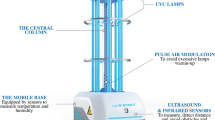Abstract
Surfaces contaminated with SARS-CoV-2 or other such viruses pose a grave threat to the safety of individuals. Mobile robots mounted with ultraviolet (UV) light attachments are ideal for disinfecting hospital rooms, shopping centers and other public spaces. This paper mainly discusses the steps involved in making an autonomous UV Disinfectant robot and its functionalities. The UV Disinfectant robot initially maps the environment with the help of a user and subsequently localizes itself in the map and is able to autonomously navigate to a selected location in the map. The user must select waypoints in the generated map determining the locations where disinfection is required. After the waypoint generation of a map, the robot can autonomously navigate through the map disinfecting given locations. The robot is equipped with 6 UVC lights around a central column, which is fixed to a mobile robotic platform that has required sensors. The robot can be used as a part of the regular cleaning crew and it aids in reducing the spread of infectious diseases, viruses, bacteria, and other types of harmful microorganisms in the environment. ROS framework is used to program the robot.
Access this chapter
Tax calculation will be finalised at checkout
Purchases are for personal use only
Similar content being viewed by others
References
Solution Design. http://solutionsdesignedforhealthcare.com/solutions/products/uv-disinfection/physics-101-inverse-square-law. Accesses 12 Dec 2020
Malayeri, A., Mohseni, M., Cairns, B., Bolton, J.: Fluence (UV dose) required to achieve incremental log inactivation of bacteria, Protozoa. Viruses. Algae. IUVA News. 18, 4–6 (2016)
Kowalski, W., Walsh, T., Petraitis, V.: 2020 COVID-19 Coronavirus Ultraviolet Susceptibility (2020)
Harris, T.R., Pagan, J.G., Batoni, P.: Optical and fluidic co-design of a UV-LED water disinfection chamber. ECS Trans., vol. 45(17) (2012). 221st ECS Meeting, May 6 – May 10. Seattle, WA
Stibich, M., et al.: Evaluation of a pulsed-xenon ultraviolet room disinfection device for impact on hospital operations and microbial reduction. Infect. Control. Hosp. Epidemiol. 32, 286–288 (2011). https://doi.org/10.1086/658329
Song, L., Li, W., Li, J.H.L., Li, T., Gu, D., Tang, H.: Development of a pulsed xenon ultraviolet disinfection device for real-time air disinfection in ambulances. Hind. J. Healthc. Eng. 1–5 (2020). https://doi.org/10.1155/2020/6053065
Anderson, D.J., et al.: The benefits of enhanced terminal room (BETR) disinfection study: a prospective, cluster randomized, multicenter, crossover study to evaluate the impact of enhanced terminal room disinfection on acquisition and infection caused by multidrug-resistant organisms. Lancet. Infect. Dis. 389, 805–814 (2017). https://doi.org/10.1016/S0140-6736(16)31588-4
Haddad, L.E., et al.: Evaluation of a pulsed xenon ultraviolet disinfection system to decrease bacterial contamination in operating rooms. BMC Infect. Dis. 17, 672–677 (2017). https://doi.org/10.1186/s12879-017-2792-z
Bentancor, M., Vidal, S.: Programmable and low-cost ultraviolet room disinfection device. HardwareX. 4, 1–13 (2018). https://doi.org/10.1016/j.ohx.2018.e00046
D’Andrea, R.: Guest editorial: a revolution in the warehouse: a retrospective on Kiva systems and the grand challenges ahead. IEEE Trans. Autom. Sci. Eng. 9, 638–639 (2012)
Marder-Eppstein, E., Berger, E., Foote, T., Gerkey, B., Konolige, K.: The office Marathon. In: ICRA (2010)
Hornung, A., Phillips, M., Jones, E.G., Bennewitz, M., Likhachev, M., Chitta, S.: Navigation in three-dimensional cluttered environments for mobile manipulation. In: ICRA (2012)
Reiser, U., Jacobs, T., Arbeiter, G., Parlitz, C., Dautenhahn, K.: Care-O-bot® 3 – vision of a robot butler. In: Trappl, R. (ed.) Your Virtual Butler, pp. 97–116. Springer Berlin Heidelberg, Berlin, Heidelberg (2013). https://doi.org/10.1007/978-3-642-37346-6_9
Ionmc webpage. http://downloads.ionmc.com/docs/roboclaw_user_manual.pdf. Accessed 10 Dec 2020
Conley, K., et al.: Ros: an open-source robot operating system. In: ICRA Workshop on Open Source Software (2009)
Goncalves, J., Lima, J., Costa, P.: Real-time localization of an omnidi-rectional mobile robot resorting to odometry and global vision data fusion: an ekfapproach, 1275 – 1280 (2008)
Liu, S., Li, S., Pang, L., Hu, J., Chen, H., Zhang, X.: Autonomous exploration and map construction of a mobile robot based onthe tghm algorithm. Sensors 20, 490 (2020)
Acknowledgements
The authors would like to thank MU Vice-chancellor Medury Yajulu, Professor Arya K Bhattacharya and Professor Bishnu Pal for providing support and key inputs during this work. We would Also like to thanks Prof. S.K.Saha from IIT Delhi who introduces us to mobile platform Robomuse 5 from where we tool the inspiration to develop this UVC robot.
Author information
Authors and Affiliations
Corresponding author
Editor information
Editors and Affiliations
Rights and permissions
Copyright information
© 2021 Springer Nature Switzerland AG
About this paper
Cite this paper
Reddy Gade, V., Seth, D., Agrawal, M.K., Tamma, B. (2021). Development of Autonomous UVC Disinfectant Robot. In: Duffy, V.G. (eds) Digital Human Modeling and Applications in Health, Safety, Ergonomics and Risk Management. AI, Product and Service. HCII 2021. Lecture Notes in Computer Science(), vol 12778. Springer, Cham. https://doi.org/10.1007/978-3-030-77820-0_11
Download citation
DOI: https://doi.org/10.1007/978-3-030-77820-0_11
Published:
Publisher Name: Springer, Cham
Print ISBN: 978-3-030-77819-4
Online ISBN: 978-3-030-77820-0
eBook Packages: Computer ScienceComputer Science (R0)




